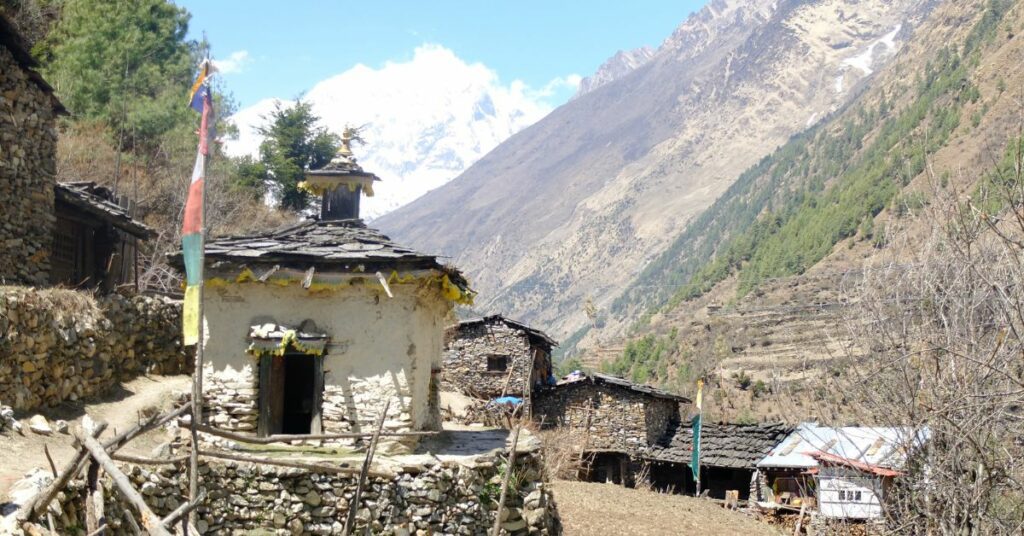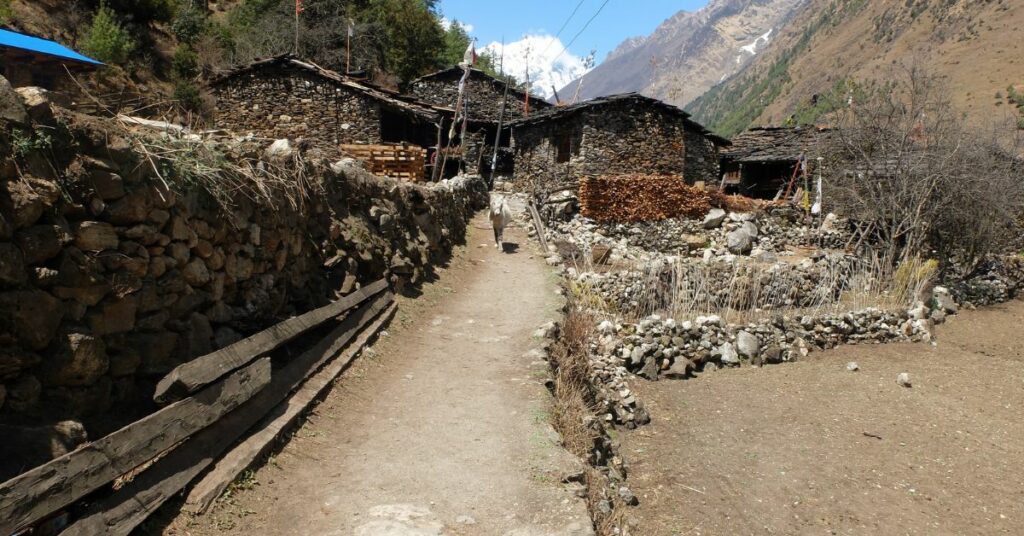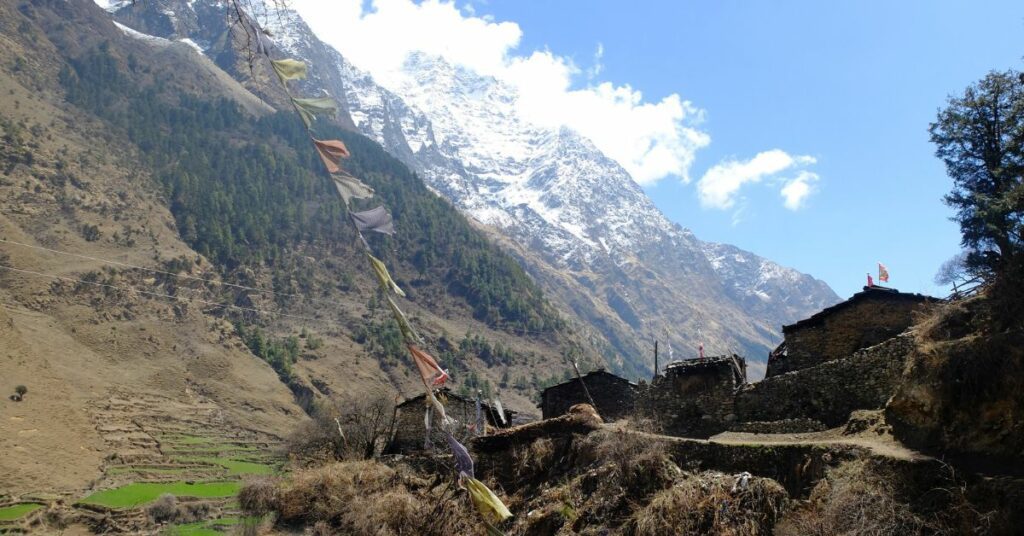The Manaslu Circuit Trek remains one of the most stunning yet less crowded routes in the Nepal Himalayas. This travel guide to the Manaslu Circuit will help you explore its route, map insights, and itinerary options. The trail lies in Gorkha and circles Mount Manaslu, the eighth-highest peak in the world. As you walk, you’ll pass remote villages, ancient monasteries, and changing landscapes. The journey begins in green lowlands and slowly reaches icy mountain passes. Despite its rising popularity, the circuit still feels untouched and peaceful. That’s why many call it a raw and quiet alternative to Everest or Annapurna. Our best Manaslu Circuit travel guide shows that planning is about more than choosing a route. You must understand the right time to trek, permit rules, and route flexibility. Some prefer direct routes, while others add Tsum Valley for a deeper experience. Every itinerary in this Manaslu Circuit travel guide brings unique highlights. The overall cost depends on your chosen path, permits, and guide services. With the right plan, the trek suits both budget and comfort travelers.
Trek Route of Manaslu Circuit: How Far is the Manaslu Circuit From Kathmandu
The Manaslu Circuit Trek starts after a scenic drive from Kathmandu to Machha Khola, which takes about 8 to 9 hours. This off-beat trail gradually climbs from the subtropical hills to alpine zones, circling the majestic Mount Manaslu. The complete route forms a loop and ends in Dharapani, from where another drive brings you back to the city. The total trekking distance spans around 177 kilometers, depending on side trips and stopovers. Compared to more commercial routes, this journey offers quiet trails and authentic local culture. From Kathmandu’s buzz to the remote Himalayan wilderness, this trek helps you explore the path better.
Comparing Different Itineraries and Routes for the Trek

While several route options exist for the Manaslu Circuit, the best itinerary balances comfort, flexibility, and altitude gain. Some itineraries stick to the classic route, while others include side trips like Tsum Valley or combine the trek with Annapurna regions. The most comfortable Manaslu Circuit travel guide itinerary follows a steady pace, allowing time to adapt to the altitude. You can customize the route based on your time and interest, making it perfect for both seasoned trekkers and beginners. Among all variations, the standard route without Tsum Valley is the most adaptable, offering scenic beauty and cultural depth without extra challenges.
Classic Manaslu Circuit Trek
This is the go-to route for most trekkers. It covers the core highlights of the Manaslu region without any diversions. You’ll experience varied landscapes, cross the dramatic Larkya La Pass, and witness the rich culture of Gurung and Tibetan communities. The trail is well-paced and ideal for acclimatization, making it the most comfortable and beginner-friendly option.
Manaslu Circuit with Tsum Valley
This route extends your journey into the sacred Tsum Valley, known for its Tibetan Buddhist culture, ancient monasteries, and untouched beauty. The valley feels secluded and spiritually immersive, ideal for trekkers looking to explore beyond landscapes. Though slightly longer, it is still customizable and offers an authentic cultural experience away from crowds.
Manaslu to Annapurna Circuit Connector
For trekkers seeking an adventurous edge, this route links the Manaslu Circuit with the Annapurna Circuit through Dharapani. It combines two major treks into one and includes both the Larkya La and Thorong La passes. This version is physically demanding but incredibly rewarding, offering dramatic altitude variation and scenic variety.
Shortened Manaslu Circuit Trek
If you have limited time, this condensed route skips some villages while maintaining the essence of the trek. It’s perfect for experienced hikers who can manage longer daily walks without needing extended acclimatization. However, it may not suit beginners or those sensitive to altitude.
Manaslu Circuit with Side Trips

This flexible version allows trekkers to add short detours to hidden gompas, side valleys, and glacial lakes. These side trips add depth to the experience without major changes to the main trail. It’s a great choice for photographers, slow trekkers, or those who enjoy exploring off-the-main-path attractions.
Cost Breakdown of Trek to Manaslu Circuit (2025/26)
The total cost of trekking the Manaslu Circuit in 2025/26 depends on your travel style, route, and whether you trek independently through an agency. While prices may vary slightly depending on season and services, here’s a general breakdown to help you plan your budget wisely.
Estimated Cost Breakdown for Manaslu Circuit Trek
| Category | Estimated Cost (USD) | Details |
| Restricted Area Permit (RAP) | $100 – $150 | Varies by trekking season. |
| MCAP + ACAP Permits | $60 | Fixed cost for both conservation areas. |
| Licensed Guide | $25 – $35 per day | Mandatory for the trek. Often arranged via a local agency. |
| Porter (Optional) | $20 – $25 per day | Helpful for carrying gear, optional but common. |
| Accommodation | $6 – $10 per night | Teahouse and lodging varies due to elevation. |
| Meals (3 times a day) | $20 – $30 per day | Typical Nepali trekking meals (dal bhat, noodles, bread, etc.) |
| Transport (Kathmandu–Machha Khola & Back) | $25 – $40 each way | Local bus or shared jeep, one way. |
| Travel Insurance | $100 – $150 | Must include high-altitude coverage (above 5,000 meters). |
| Misc. (Snacks, Wi-Fi, charging, etc.) | $50 – $80 total | Optional personal expenses during the trek. |
Note: Total Estimated Cost (Mid-range Trekker): $700 – $1,100 USD for 12–15 days
Permits
Trekking the Manaslu Circuit requires three essential permits, all of which must be arranged before or through your trekking agency. Independent trekking without a guide is not allowed in this restricted region. Here’s a complete breakdown:
1. Restricted Area Permit (RAP)
Season Cost per Person September to November $100 for the first 7 days + $15 per day after that December to August $75 for the first 7 days + $10 per day after that
- This permit is mandatory from Jagat to Dharapani.
- It can only be issued through a government-registered agency.
- A minimum of 2 trekkers with a licensed guide is required.
2. Manaslu Conservation Area Permit (MCAP)
- Cost: $30 USD per person (no daily charge)
- Needed from Philim onwards
3. Annapurna Conservation Area Permit (ACAP)
- Cost: $30 USD per person (no daily charge)
- Required after crossing Larkya La Pass into the Annapurna Region
Notes:
- No TIMS card is required for the Manaslu region.
- Always carry printed copies of your permits during the trek.
- Ensure your agency helps secure the permits in advance to avoid delays.
Ideal Time to Trek
The Manaslu Circuit is a high-altitude trek that runs through remote terrain. This can make or break your entire trekking experience. Choosing the right season directly affects trail conditions, visibility, comfort, and overall safety.
Spring (March to May)
Spring is one of the best times to trek the Manaslu Circuit. The weather stays stable, with clear skies and blooming rhododendrons brightening the trail. Daytime temperatures are pleasant, especially in lower altitudes, while nights remain chilly in higher sections. Trekkers enjoy stunning views of Mount Manaslu, as well as a lively trail with just the right number of fellow hikers. Because snow starts melting during this season, crossing Larkya La Pass becomes more manageable. Spring offers the perfect balance between scenery and safety.
Autumn (September to November)
Autumn is another peak season for the Manaslu trek, mainly because of its post-monsoon clarity. Skies are crisp and blue, mountain views are breathtaking, and the trail stays dry and solid. The air feels clean after the summer rains, and the landscapes look vivid and sharp. Temperatures remain moderate during the day and cold at night, especially at higher elevations. It’s a popular time, so expect some crowds around teahouses. Still, this season offers ideal trekking conditions and reliable weather.
Winter (December to February)
While some experienced trekkers choose winter, it’s generally considered off-season for the Manaslu Circuit. Snowfall can block trails, especially near Larkya La Pass, making the crossing risky or impossible. Many teahouses close due to cold and limited visitors. Temperatures can drop below freezing, especially at night, making the trek uncomfortable for most. However, if you’re well-equipped, prefer solitude, and don’t mind harsh weather, winter offers a raw and peaceful version of the trek.
Monsoon/Summer (June to August)
Monsoon brings heavy rainfall to the region, making the trail slippery, leech-infested, and prone to landslides. Dense clouds often block mountain views, and flights or road travel to trailheads may face delays. While the lush greenery looks beautiful in lower regions, the overall trekking experience suffers. Only highly experienced hikers or researchers venture during this season. For most, monsoon is not recommended due to unpredictable weather and poor visibility.
How Difficult is the Trek? Risks During the Manaslu Circuit Trek

The Manaslu Circuit Trek is a physically demanding adventure that pushes both body and mind, especially above 5,000 meters. The highest point of the trek, Larkya La Pass, tests endurance with thin air and freezing temperatures. As altitude increases, so does the risk of altitude sickness, even for experienced trekkers.
The route passes through remote areas with limited access to medical help or evacuation. Sudden weather changes, snowfall, and steep sections can make the journey risky at times. There have been reports of accidents and even fatalities in past years, mostly caused by poor acclimatization or lack of preparation. These risks highlight the importance of awareness and readiness before starting the trek.
To ensure a safe journey, it’s important to read through the Safety Guide for the Manaslu Trek. It helps you prepare for high-altitude conditions, changing weather, and emergency situations. With the right precautions, guidance, and mindset, the Manaslu Circuit Trek can be both safe and unforgettable.
Packing All the Essentials for the Trek
Packing smart is key to enjoying the trek without unnecessary weight or missing must-haves. Since you’ll be trekking in remote high-altitude terrain, it’s crucial to carry gear that’s lightweight, weather-appropriate, and comfortable. Always prepare for cold, wind, and changing weather, especially at higher elevations. Below is a list of essential items to pack for a safe and successful trek:
Essential Items for Manaslu Circuit Trek:
- Backpack (40–60L) – Comfortable with rain cover
- Daypack (10–20L) – For daily use and valuables
- Waterproof trekking boots – Well broken-in and ankle-supporting
- Thermal base layers – Top and bottom for cold nights
- Insulated jacket – Down or synthetic for warmth
- Fleece or softshell jacket – For layering
- Waterproof jacket and pants – For rain, snow, and wind
- Trekking pants – Lightweight and quick-drying
- Gloves and woolen hat – For cold mornings and high altitudes
- Trekking poles – Help reduce strain on knees
- Sleeping bag (-10°C or lower) – For cold teahouse nights
- Headlamp with extra batteries – Useful in early hikes or outages
- Sunglasses and sunscreen – UV protection is a must
- Reusable water bottles or hydration bladder – Stay hydrated
- Personal first aid kit – Include altitude medicine, painkillers, and bandages
- Snacks and energy bars – For long hiking days
- Quick-dry towel and toiletries – Pack light, biodegradable if possible
- Passport and permits – Keep them safe and dry
- Cash in Nepali rupees – No ATMs once you start the trek
Trekking in the Manaslu Region
The Manaslu region opens up to lesser-known trails and spiritual hideaways. Among these, the Tsum Valley Trek and its combination with the Manaslu Circuit stand out for trekkers seeking offbeat and immersive experiences. If you’re looking to go beyond the usual route, these treks offer both solitude and authenticity.
Tsum Valley Trek
The Tsum Valley Trek is a hidden gem in the Manaslu region, tucked away from the mainstream trails. Known for its untouched culture and peaceful monasteries, this trek takes you deep into a sacred Himalayan valley. You’ll walk through traditional villages, visit centuries-old gompas, and interact with locals living a simple, spiritual life.
Manaslu with Tsum Valley Trek
If you want a longer, more immersive adventure, the Manaslu with Tsum Valley Trek is a perfect combination. This extended trek blends the raw beauty of the Manaslu Circuit with the spiritual depth of the Tsum Valley. It’s ideal for trekkers looking to experience cultural diversity, remote wilderness, and dramatic landscapes all in one journey.
Frequently Asked Questions
Is the trek to Manaslu Circuit Safe?
Yes, the Manaslu Circuit Trek is generally safe for trekkers who are well-prepared and follow the right precautions. The trail is remote and challenging, but with proper gear, a trained guide, and awareness of altitude risks, it becomes a rewarding journey. Many trekkers complete it without issues, but weather and terrain can be unpredictable. To ensure a safe journey, it’s important to read through the Safety Guide for the Manaslu Trek. It prepares you for altitude challenges, route risks, and emergency tips.
Can I trek Manaslu without a guide?
No, trekking the Manaslu Circuit without a guide is not allowed. The Government of Nepal has declared the region as a restricted area. You must hire a licensed guide and travel with at least one other person. This rule ensures safety and helps in environmental conservation. Guides also help you navigate local customs, stay on track, and provide emergency support if needed.
What is the average cost to travel to the Manaslu Circuit?
The average cost of the Manaslu Circuit Trek ranges from $900 to $1,600, depending on your travel style. Budget trekkers can spend less with basic teahouse stays, while those seeking comfort will pay more. The cost includes permits, guide and porter fees, food, accommodation, and transportation. Prices may also vary by season, trek length, and side trips like Tsum Valley.
What are the permits required for the trek?
To enter the Manaslu Circuit, you’ll need three main permits:
- Manaslu Restricted Area Permit (MRAP) – $100 for the first 7 days (Sep–Nov), then $15/day
- Manaslu Conservation Area Permit (MCAP) – NPR 3,000 (~$22)
- Annapurna Conservation Area Permit (ACAP) – NPR 3,000 (~$22) Make sure to carry passport-sized photos and a valid passport for the permit application process.